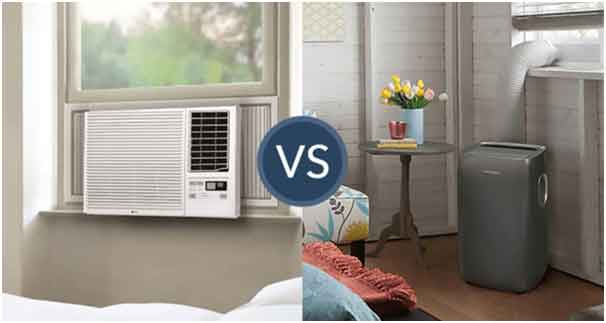In this article, we will know Portable vs window air conditioner which is better? Today’s air conditioning systems are innovative, with apps that can schedule them, check interior air quality, and notify you when filters need to be replaced.
Anyone seeking new room air conditioning goods (that don’t rely on ductwork) must first decide whether to utilize a portable air conditioner on the floor or a window air conditioner nearby. Is it the window?
Let’s go through the key features of air conditioners and the distinctions between portable and window units to decide which is best for you.
You can find recommendations on the best smart portable air conditioners and the finest window air conditioners you can buy if you want to look into suitable models.

Design
It’s crucial to remember that portable and window air conditioners perform the same essential functions: refrigerants pull in and store heat from neighboring indoor air and cool rooms and then release heat and light. There is too much moisture in the air outside. It’s the same for both options. Thus their appearance is mainly determined by how they’re used.
Portable air conditioners are designed to sit on the floor and are available in various shapes; however, the majority are tower-shaped, mobile, and often come with wheels for easy shifting. To run a vent to vent excess heat and water vapor outside, they are frequently placed near a window (more on that below). Only a few placement conditions apply otherwise.
On the other hand, window air conditioners are designed to be installed (more or less) permanently in a room that formerly had a glass. This allows them to see outside and transfer heat into the atmosphere, and link to a permanent sewer system if necessary. Window air conditioners often have a specified shape that is appropriate for particular window types.
It also means you’ll have to give up the window seat to use it, which may be more difficult in some situations than in others. You can consider investing in one after reading some of the best windows AC reviews so you make the right purchase for your home.
Portable vs window AC efficiency
Window air conditioners are typically more extensive and more powerful. According to appliance analyst studies, their coverage improves as power grows (up to 700 square feet) (most units’ window air conditioners cannot simply cool larger areas).
That’s why window air conditioners are the most efficient alternative for homes and lofts, and portable air conditioners can’t match their efficiency.
It’s also worth noting that some window air conditioners are hybrid versions that can go from cooling to heating mode. This does not make them more efficient, but it does improve their usefulness year-round, which some users may value.
Cost of Portable and window air conditioners
Portable and window air conditioners typically cost between $200 and $400, depending on the size of the product and the number of functions it contains. Portable air conditioners with dehumidification and many intelligent features are the most expensive, costing $600. Hybrid window versions with heating capabilities can go even higher.
Facility
Installing a portable air conditioner is simple. Connect the AC vent to a nearby window when you’re ready to utilize it. These air conditioners frequently have window inserts or customized panels for a better fit. However, no additional setup is required.
On the other hand, window air conditioners are meant to be self-installed and bolted into the window frame. Lifting the equipment is frequently one of the more challenging aspects. However, if you have to remove a window completely, and are not sure how to do it, hiring a specialist is great.
Handling and Portability
There are two types of portable air conditioners, each with significant differences. As a result, we wanted to take the time to talk about it.
The first method involves routing a vent line from a neighboring window to a safe floor. This popular style takes some time to put up but can be relocated to different rooms as needed and stowed away for the winter to conserve space.
However, it necessitates an open window and maybe a hole in the window grills, which increases the chance of bugs or pollen entering the house (many models have weatherproofing features to prevent this, but the quality may vary). Although this is not usual with domestic appliances, this model can be connected to a ceiling vent in some situations.
Because there is no need for temporary ventilation from a window, the second type of portable unit is known as a “ventless” device, sometimes known as an evaporative cooler. On the other hand, an evaporative cooler is a fan that also delivers excellent moisture to the air in water vapor, cooling the skin. This is a good option for PCs with no open windows or comparable situations.
Window air conditioners, on the other hand, aren’t portable. They can be removed or replaced in exceptional circumstances, but they are usually considered part of the structure.
Conclusion
Unless you require a portable air conditioner, a window air conditioner is often easier to use and delivers a higher return on investment. In the following cases, a mobile model is a superior choice:
- On the first level, windows may be too high above the floor for a window air conditioner to be placed.
- A window’s form or style prevents it from being used as an AC window.
- You don’t want to give up your windows’ light or circulation.
- The use of an AC window is prohibited by law (sounds weird, but some HOAs or complex rules mention it).
- As previously stated, several regions lack access to windows or openable windows.
- You already have central air conditioning, but you’d like to cool down on the spot during a scorching day.
